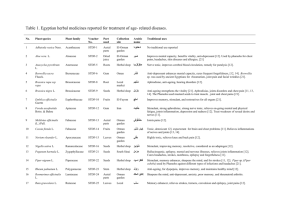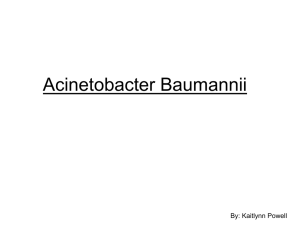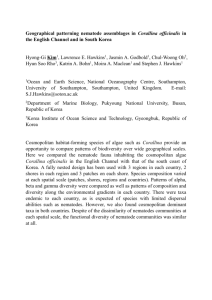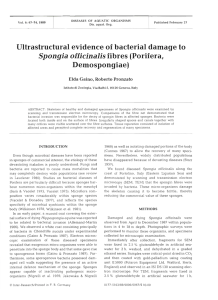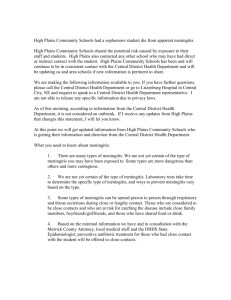Axinella polypoides Spongia officinalis
advertisement
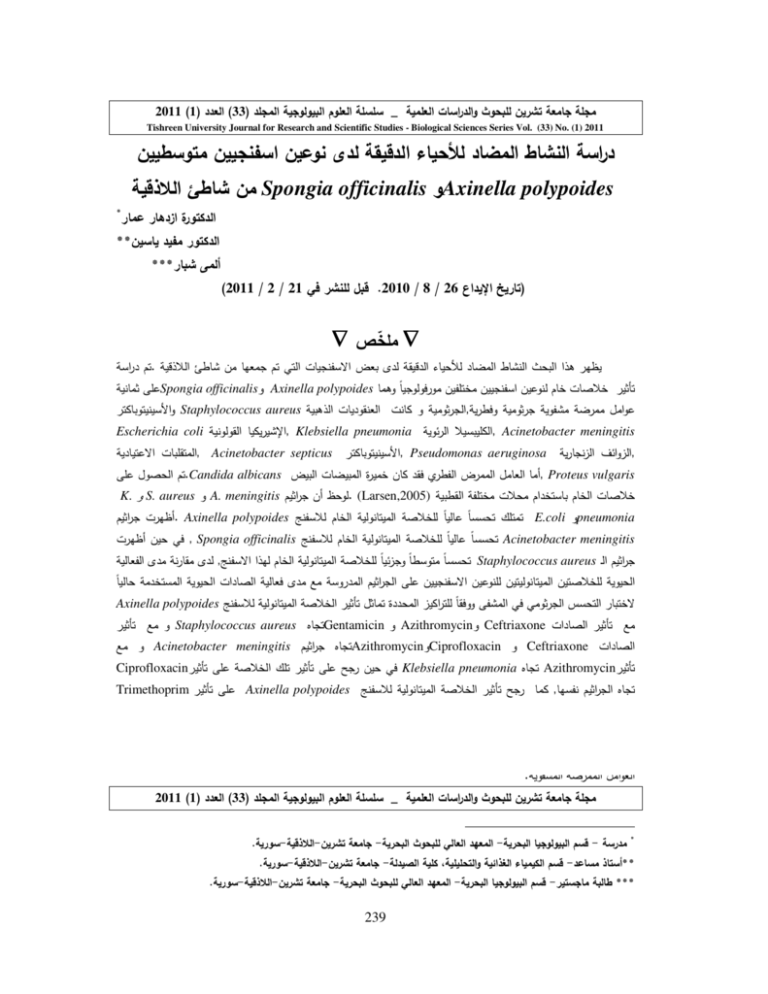
2011 (1) (33) _ Tishreen University Journal for Research and Scientific Studies - Biological Sciences Series Vol. (33) No. (1) 2011 !" #! ! $% & Spongia officinalis Axinella polypoides * # '( )* ** " * *** ,(2011 / 2 / 21 34 ! 5 .2010 / 8 / 26 ./ 0 ) ∇ 687 ∇ % . ! " # $ %& / 1+-Spongia officinalis) Axinella polypoides $) ())*%) +, -) , ., %/0 %4)5) Staphylococcus aureus $ ) 4 ) )/%,% *) )/% ) "% 2)Escherichia coli )) 4%7, Klebsiella pneumonia )6% +4, Acinetobacter meningitis - +, Acinetobacter septicus %4)5, Pseudomonas aeruginosa %8 96)8, 1+- 2). .Candida albicans " :%, 4 * ;% % 2 <, Proteus vulgaris K. ) S. aureus ) A. meningitis /% < & ). (Larsen,2005) +, , , ., /% %&<. Axinella polypoides > , ) .,+ (- ( =+ E.coli )pneumonia %&< * , Spongia officinalis > , ) .,+ (- ( Acinetobacter meningitis % ,> , ) .,+ (68) ( ) ( Staphylococcus aureus ? /% ( , ) . * @ )% /% 1+- -)+ ) .,+ ) Axinella polypoides > ) ., %/0 2/ : 84%+ (*)) 1 * )/% A %, %/0 @ ) Staphylococcus aureus BGentamicin ) Azithromycin) Ceftriaxone . %/0 @ @ ) Acinetobacter meningitis /% BAzithromycin)Ciprofloxacin ) Ceftriaxone . Ciprofloxacin%/0 1+- ., =+ %/0 1+- C% * Klebsiella pneumonia B Azithromycin%/0 Trimethoprim %/0 1+- Axinella polypoides > ) ., %/0 C% 4 , /% B Ceftriaxone . %/0 @ 2/ * Escherichia coli /% B sulfamethoxazole ... /% B Nalidixic acid ) Ciprofloxacin) , ! " % , Spongia officinalis, Axinella polypoides : " * .) "% 2) 2011 (1) (33) _ .;$%; ; 3 < ; ; * .;$%; ;= * > ?$@ * ;# $ -** .;$%; ; 3 < ; ; *** 239 ) -) ! " % % , ,%- Spongia officinalis ) Axinella polypoides Tishreen University Journal for Research and Scientific Studies - Biological Sciences Series Vol. (33) No. (1) 2011 Studying the Antimicrobial Activity of two Mediterranean Sponges of Latakian Coast: Axinella polypoides & Spongia officinalis Dr. Izdihar Ammar * Dr. Moufid Yassine** Alma Shabbar*** (Received 26 / 8 / 2010. Accepted 21 / 2 /2011 ) ∇ ABSTRACT ∇ The antibacterial and anticandidal activities of sponges collected from Latakian coast were closely examined. The crude extracts of two sponge species Axinella polypoides and Spongia officinalis were tested against eight isolated nosocomial pathogens: Staphylococcus aureus, Escherichia coli, Acinetobacter meningitis, Klebsiella pneumonia, Acinetobacter septicus, Proteus vulgaris, Pseudomonas aeruginosa and the yeast Candida albicans. It’s been found that methanolic crude extract of Axinella polypoides had antimicrobial activity against both Gram positive and Gram negative bacteria; that is, A. meningitis, S. Aureus, K. pneumonia and E.coli showed high susceptibility to MeOH crude extract of Axinella polypoides. While Acinetobacter meningitis showed high susceptibility to methanolic crude extract of Spongia officinalis, Staphylococcus aureus had partial moderate sensitivity to the same crude extract. Furthermore, the findings of antibacterial activity of MeOH crude extracts of both studied sponges were compared to the efficiency of some antibiotics that were tested against the same bacteria at given concentrations. In result, it was found that MeOH crude extract of Axinella polypoides ,Ceftriaxone, Azithromycin, Gentamicin were equally efficient against Staphylococcus aureus. While MeOH crude extract of Axinella polypoides was as efficient as Azithromycin against Klebsiella pneumonia. Ciprofloxacin was less efficient than the mentioned extract against the same bacteria. MeOH crude extracts of both of Axinella polypoides and Spongia officinalis were similar in activity to Ceftriaxone, Ciprofloxacin, Azithromycin against Acinetobacter meningitis .As for E.coli , MeOH crude extract of Axinella polypoides , Ceftriaxone, Ciprofloxacin, Nalidixic acid were similar in activity while Trimethoprim sulfamethoxazole less active than the same extract against E.coli. Keywords: Axinella polypoides, Spongia officinalis, Antimicrobial activity of marine sponges, Nosocomial pathogens * Assistant prof., Dept of Marine biology at HIMR, Tishreen University, lattakia, Syria. ** Associate professor, Dept of Food Biotechnology, School of Pharmacy, Tishreen University, lattakia, Syria. ***postgraduate Student in Marine biology at HIMR, Tishreen University, lattakia, Syria. 240 Tishreen University Journal. Bio. Sciences Series 2011 (1) (33) + )) )+ % + : ) 5 8- Secondary metabolites )/ + +4 - 4% ,.J)5 * :%*)) ( , %" %. )%L .,) %).[ 1] @. +4 6) -. * , 4 ,K+, 4% 9. . [2]% 64 $%M) $%M @ % 4% =+ %45 Immunosuppressives - /) Anti-inflammatories N " 1O &) N " ) Antibacterials /%+ ") Antivirals)%* ") Antitumors%)< ") [3]. +, - K6., 4% =$) Antifungal % * N * , 64 4%+ $ %. * %*< 9% :- 90 > * ,, : -) 64 -) 2/. (4;1) ;+ 2? 6$ P) QO 4 % ?L ) / < 4, &) .., )+, ., =+ ( : .[8;7;6;5] ?-* 2? 6)4 ?, ) () ? 64 ? 4% 4% 28- # , )%L .,) 5 4% 28- * .[10; 9] % %4 - ! :" < % ) 64+ (R 0( + %*) ( N)/ :%* Axinella > 8 > "% ) 64 B -* $5 )/ + Q * %( ) N+ 245 S # ,> 24 %/0 < 4 ! :" < & ).[13; 12; 11;10] Spongia P) $< %4) ;% ) %/4< > +4 ) ) -% Nosocomial ) "% 2) - 1+- ;) % .[14; 5] officinalis * * # ) 0 Nosocomial infections ) Q,5 %)& - )T) pathogens opportunistic pathogens8 /% - 6% 24 > ) ,Hospital- acquired infections Q,5 # . .U "%- %/4< (- /) (Hospitalized patients) 1"% %) /% ) ( + J)% ) + ) 8) % - V)%) ) 8 * ( M ) %/4< 0 * 4 "% 2) 8. ;84% . 8 ) ;) 8 ) . [16; 15] ) .+ ) :A4'- ' -) , .,+ ! :" - 94 1O % B$ 9 @ % ) "% 2) 1+- $%/0 %) ( ))*%) +, # $ $< 8). 9 @) ( =+ ; > ) ,( , ) . %/0 .% + $%. *"7 ;% %. - :6* 4% 28- 4O 241 ) -) ! " % % , ,%- Spongia officinalis ) Axinella polypoides :C B? :$%" ) @ .1 4 Spongia officinalis ) Axinella polypoides $ X))*%) +, -) @ J% - 30-10 J- 1+- Demospongia )%L 9. 1O (1,2) +4 * $ %* 2007 - % 2)5 9. 2, =) , Scuba diving ) A L 5 & $ (3)% 24 (35°35'37"N 35°45'20"E) / 7 J*) ? .K, (°20Y) :%% % * & ) A4< * ")) *% )%L )< / )4 Spongia officinalis?)Axinella polypoides $ *, % ). ;) 1+- 9, $ %/0 % 9 ))*%) *, (1)% 2) * )$ 4 [18; 17] ))*%)) . #! 5* "= 3"!= D (1) 5 9.) 6 B) ) ) % >O +. Axinellidae % Halichondrida P) Axinella polypoides (Schmidt,1862) Spongiidae Dictyoceratida Spongia officinalis (Linnaeus,1758) ) 24 .O P)% [ )% 24 P% " @ 2. % & %M ) )+ % )$ ,+, C .) . 10 J- - # \ ) @ +4 24 ) >O @") .=)) , C :)8 ) ) )$) ,C 1+- (M %*8 J- - # \ ) ,% 30 Spongia officinalis .! :(2) 5* Axinella polypoides .! :(1) 5* 242 Tishreen University Journal. Bio. Sciences Series 2011 (1) (33) + )) )+ % + 3! ' !4 :(3) 5* : !? * .2 "% 2) 8- ) , * 5 1 5 1+- 2). 4 % *) )/% P)5 28-) ) 1 1"% :),0 +, "% - ) API- )/% + , /% P)< % %, %<) ,+, -%8 )< , /% (- $%, ] 5 2 .26 )4+M)/ ) , $%/4 < ,20E :(2) % 2) * )$ 4 "% % * 1O *"7 ' 8 3 F = E (2) 5 %. :%, 5 (") ) \)+ Candida albicans " B% Staphylococcus aureus$ ) 4) M 26 Acinetobacter meningitis%4)< 4) M 26 Klebsiella pneumonia)6% ++4 2) Escherichia coli)) 4% (") ): 8% Pseudomonas aeruginosa%8 96)8 B% Acinetobacter septicus%4)< Proteus vulgaris- + : 8 !"F =%8 ,# 5= .3 %< ) [11] ., 1+- 2). % * % Larsen % 2 % :- , ., 1+- 2). +- " . , ., 1+- 2). ) , 1+- .%) %, ., %,) K, ) > %" $) 243 ) -) ! " % % , ,%- Spongia officinalis ) Axinella polypoides :G!"F 5 - +8<) % +M / + ) %, ) * 4% $ Y47 % Y K+,+ Fume hood )$ " ) : 4% ) 8) / %L . K ) 31 :%L. @ 1O P) 24 @ ) 8) :6%8H < 2 ) 2) $) ( , ) , ) )"- // , : @ + @ 1+- K, +- 2.>5 8) , 2 2.4) ^ ^ #/ ( 2 )2) , * *%L :%% %) )$ " +& 4 * -24 , // + % *) % #/ ( ) 2 )< 2 , / + % *) % :% ) , ) @ ) J % + % * : ) :% ( 2 )4 ^ ^ * 24 : < 27 : ) 4 @ +- 24 2) , *%L :%% %) )$ " +& 4 ) C% ., - @ 2.*) )$ " P^) 24 @ 9 $) P) 24 ., -) #/ @ * ) ,°4Y % ., & 4 ., ) < 2 ., ) ) ., ( 8 8 ) 8 !"H =%8 ,# 5= % 4 # ,Rota.Vap. %) %, , N - P) 24 ., 2.* 87 ) %) -%) 68 600 L" %/0 ) (°40Y30) 2 " 6 + :%% ., $) P) 24 , ., -) #/ 1+- 2). . N 4< % & ) (:%L. )-) * * ") 4 ., ) < 2 ., ) ) % )< Kirby-Bauer %) %4 % )/% A %, * , °4Y :%% .Disk diffusion .% :Inoculation B F .( - Yeast Potato Dextrose ) /%+ - )$) )$ %) %MR) %L ;% J < 6+ (% + %) ) /%+ )4+4)/) 26 ) , )% 5 ,(%) ) ; %) N)< *) )/% +- N5 N)< 24 * :- :%O %M ,\ A) (94))5 )))8* + 2. 25 ;) N< " %M / , % \+C 1+- _%*) %) K ) ( % *) )/% 24) N+ 21 % ,< $ J? 5 _%?* ?4 , )/% (+ 4 4))$%) %MR 1+- ) -%8 J 5 .Candida albicans% YPD %MR 1+- ?) :Susceptibility test3I J 8 40 % %O L -) 4 , ., 20 `l % B$ * - - A %, %O ( < =) ,) . @ % \$ )/% A + -)+ , ., B )/% A ;< %)& )) 20 ` l) 10 `l 244 Tishreen University Journal. Bio. Sciences Series 2011 (1) (33) + )) )+ % + 20 `l E.coli ) K. pneumonia) S. aureus ) A. meningitis /% A %& 2)5 > ) , ., (20 `l )? +6 % (Whatman, No.1) %) K%5Impregnated N% )5 1+- ") / , 2) %/R K+,+ 9 1 4%) ,< P) 24 , ., " $ ,: ;0 N% %M $ K% ,), )/% (Inoculated))% .% + -24 : °27 :%% %), /%+ - 24 :) °37 :%% % J 5 :Findings InterpretationG? ! ) ! :" A - ) >6 +) :% / % A :] ) 1+-[9] .,+ ;% ) )/% A )< (Y)) (+) 9" A (++) ) (+++)- / $ )) - • 10 Y8 % / $ )) • 15Y11 % / $ )) • 15 < % / $ )) • * )/% A %, , " % ) . -) ) ., *) * % %O L %) %) % 2 P) ( 1 . ., =+ / /% B . \0 8) B-lactams -) #/ 2 %)) :(30 µg) Ceftriaxone Acinetobacter ,Staphylococcus aureus) /% A %, %+ , ) 9 @) (Escherichia Coli, Meningitis %, %+ , ) Macrolides )%4+ : (15 µg) Azithromycin ( Klebsiella pneumonia, Acinetobacter meningitis , Staphylococcus aureus) /% A %+ , ) Aminoglycoside 8)4+M)! :(10 µg) Gentamicin Staphylococcus aureus /% A %, %, %+ , ) Quinolones ))4+ : (30 µg) Nalidixic acid (E.coli) /% A %+ , ) Fluoroquinolones ))4)%)++ : (5 µg) Ciprofloxacin ( Escherichia Coli, Acinetobacter Meningitis, Klebsiella pneumonia) /% A %, , ) )+ 1O :(1.25 µg) Trimethoprim sulfamethoxazole (E.coli) /% A %, %+ : ! G? ! 245 ) -) ! " % % , ,%- Spongia officinalis ) Axinella polypoides B -) 4 )4 ) < 2 ) ) .,+ ) %, % % % # ,1 1"% :),0 +, "% - )8 ) /% ! (" ( =+ ) , ., * :)) 4%+ 64 < 1O *)% ) .+ ) %4 B * 1+- &* ) /%+ ;)+, L 1+- %/T < 4 .( * , ) . %/0 @ $%/0 % 1O * $)[19] , 1O 1)5 % = * N ) , .,+ ! " > < 1O A %, >6 & )) [9]*%M))%4 ) + ;8 Spongia ())*%) 9+, / > @ % %4< * %&< Axinella polypoides \* 1+- B) 24) > ))*%) %/0 # % % \O %< $) , officinalis # ) ., $< % %&<) [6;5] +4 1+-< * ) P% * ) K, + 0 + < 4 ,[16] )+, M5 J%, 2)/+ 4 %/0 %) , [20 ;7] + ) ) + 2 >5 - P* * ,) Axinella > ) ., %/0 < & ) 4 ) %4 P)5 1+- , ., ) ) )% 5 1+- Spongia officinalis > ) ., 1+-< polypoides 64+ "%- %/4< )* ) 6 ) Axinella polypoides >* ,))*%) 9, = 64 + 6 %+ C )* 24 1+- -8)) : N)/ 2") ( "* P8) & %M) 2+ N)/ -) +4 ) Spongia officinalis> 2), 30 %/4< J- 1+- )) )* / P) < , 10 J- 1+- ) 2)5 5 P) < )/ + =+ Q7 , 64 %/0 2 # , /% A %, >6 %& # A %, C" $) ! (" %( ) N+ # , S. Officinalis ) A.polypoides -) 24 , ) .,+ S.aureus? > ) ., B 21< / % ) (- ( %L S .aureus /% %&< ., B +12 / % ) (68) ( ) ( ) (3) 2) (5) % 24 Axinella polypoides ) . @ %) (3) 2) (4) % 24 Spongia officinalis > ) Y9 @) ;) .) Ceftriaxone ? %&< * , Gentamicin, Azithromycin ,Ceftriaxone 21 1+-< / % ) 30 µg 84% - S .aureus /% B - * (#/ 2 %)) :),% 5 , )%4 )$) Azithromycin ? (4 < 4 Staphylococcus ? B - * % &< < 8)4+M)< )$) Gentamicin ? =4) $ ) (3) 2) (11) % 24 /+ 19 ) 2)! 21 1+-< / % ) (15 µg)84% - aureus ^ (- ( %L /% $) Acinetobacter meningitis /% %&< ., 24 * , (7,6)+4 (4) 2) 21< / % Spongia officinalis) Axinella polypoides? ) <,(30 µg) 84% - 20 / % /% =+ B - * 246 Ceftriaxone ? %&< Tishreen University Journal. Bio. Sciences Series 2011 (1) (33) + )) )+ % + %& =4 (15 µg) 84% - 20 / % /% =+ B - * %&< * Azithromycin? (4) 5)(12) % 24 5µg 84% - 19 / % /% B$ B - * Ciprofloxacin? .,+ 20 / % ) (- ( %L /% $) Klebsiella pneumonia /% < (5)2)Spongia officinalis ? ) ., B A 4) Axinella polypoides? ) =+ B - * 2)5 %&< * Ciprofloxacin ? )Azithromycin ? 24 @ %) ,(8)24 % ) (30 µg) 84% - ) * %&< * / < ,20 / % ) (15 µg) 84% - /% - * Axinella polypoides > ) ., %&< .(13) % 24 (5)2) 15 / Spongia > ) ., %& * , 20 / % ) E.coli ? /% B ? /% B - * Ceftriaxone ? %&< ,(9) 24 (6)2) /% =+ B *officinalis 1O ) % )$) Nalidixic acid? %&< =4 ,(30 µg)84% - 20 / % E.coli ; Ciprofloxacin ? %&< 4 21 1+-< / % ) (30 µg)84% ?- - ?* ))4 Trimethoprim ? < O ,(5 µg) 84% - 20 / % - * ))4)%)+ 1O * ,(14) 24 (6)2) (1.25µg)84% - 15 / % ) * < sulfamethoxazole ) Proteus vulgaris) Acinetobacter septicus) Pseudomonas aeruginosa /% %& Spongia ?) Axinella polypoides? 24 ) .,+ ( Candida albicans? % * =4 * %?&< * ,Spongia officinalis > < 2 ., < ,(7) 2) officinalis P)5 * ,(10) 24 (8) 2) 14 / % S .aureus ?/% B 68) ) Axinella polypoides >! < 2 ., < 4 ,., =+ ( 4 ) )/% )4 ., %/T %5 =4 ,(8)2) % ) )/% @ 1+- %/0 ;< 2) )% 4 ) )/% P)5 ;< 1+- Spongia officinalis?) Axinella polypoides .(9)% 8 ! =%8 S.aureusK I J 8 G? ! (3)5 = L D ! S.officinalis A.polypoides 5* Gentamicin (15 µg) Azithromycin (15 µg) Ceftriaxone (30 µg) 19 +++ >21 +++ >21 +++ Spongia officinalis 20 ul)( 12 ++ Axinella polypoides (20 ul) >21 +++ Staphylococcus aureus 8 ! =%8Acinetobacter meningitis I J 8 G? ! (4)5 Azithromycin( 15µg) 20 +++ = L D ! S.officinalis A.polypoides 5* Spongia Axinella Ciprofloxacin( Ceftriaxone officinalis polypoides 5µg) (30µg) (20 ul) (20 ul) 19 20 >21 >21 +++ +++ +++ +++ 8 ! =%8Klebsiella pneumonia I J 8 G? ! (5)5 = L D ! S.officinalis A.polypoides 5* 247 Acinetobacter meningitis ) -) ! " % % , ,%- Spongia officinalis ) Axinella polypoides Azithromycin (15µg) Ciprofloxacin (5µg) Spongia officinalis (20 ul) 20 +++ 15 ++ _ Axinella polypoides (20 ul) 20 +++ Klebsiella pneumonia 8 ! =%8E.coli K I J 8 G? ! (6)5 Trimethoprim+ sulfamethoxazol e (1.25µg) 15 ++ = L D ! S.officinalis A.polypoides 5* Nalidixic Ciprofloxacin Ceftriaxone Spongia Axinella acid (5µg) (30µg) officinalis polypoides (30µg) (20 ul) (20 ul) >21 +++ 20 +++ 21 +++ 20 +++ - E.coli 8 ! =%8 ! * I L J 8H G? !(7)5 S.officinalis A.polypoides 5* Proteus vulgaris _ Acinetobacter septicus _ Pseudomonas aeruginosa _ Candida albicans _ _ _ _ _ Axinella polypoides (20 ul) Spongia officinalis (20 ul) S.officinalis A.polypoides 5* 8 - 5H =%8 ! * I .!F J 8 G? ! (8)5 K.pneumonia S.aureus C. albicans P.vulgaris A.septicus P.aeruginosa A.meningitis E.coli - 14 ++ - - - - - - - - - - - - - - S. officinalis (20 ul) A.polypoides (20 ul) S.officinalis A.polypoides 5* 8 ! *< =%8 ! * I .!F J 8 G? ! (9)5 K.pneumonia S.aureus C. albicans P.vulgaris A.septicus P.aeruginosa A.meningitis E.coli - - - - - - - - - - - - - - - - 248 S. officinalis (20 ul) A.polypoides (20 ul) Tishreen University Journal. Bio. Sciences Series 2011 (1) (33) + )) )+ % + S.aureus I M J( 5)5* S.aureus I 3?( J(4) 5* AxpK 8 ! =%8 S.o 8 ! =%8 A. meningitis I M J (7)5* A. meningitis I M J (6) 5* S.oK 8 ! =%8 AxpK 8 ! =%8 E.coliI M J (9 )5* K.pneumonia I M J ((8)5* AxpK 8 ! =%8 AxpK 8 ! =%8 S.aureus I 3?( J :(10) 5* SoK 8 - 5H =%8 Axp :Axinella polypoides So: Spongia officinalis 249 ) -) ! " % % , ,%- Spongia officinalis ) Axinella polypoides : 3' = 6F S.aureus K J <N (11) 5* AzithromycinKCeftriaxone K Gentamicin K Ciprofloxacin K 3' = 6F Acinetobacter meningitis K J <N (12) 5* AzithromycinK Ceftriaxone K : = 6F Klebsiella pneumonia K J <N (13) 5* Azithromycin ,CiprofloxacinK 3' = 6F E.coli K J <N (14) 5* Nalidixic acidK KCiprofloxacin K CeftriaxoneK Trimethoprim sulfamethoxazole K 250 Tishreen University Journal. Bio. Sciences Series 2011 (1) (33) + )) )+ % + : = !H 24 %/0 .,+ ) ! " < 2, > P)+ ) .,* +4 1+-< * ) P% d B) N)+<) > %4< * 24 1+- & -8)) \)/ ) 6 B) 8 ; Axinella polypoides %M \)/) +4 B) 8 ;, Spongia officinalis P)+ ) ., @)< 9 Axinella polypoides P)+ , ) ., 0 4 ,& % & ) .%L +) /% B Spongia officinalis P) ) ., Axinella polypoides , ) .,+ ! " + % , Ciprofloxacin,Gentamicin , Azithromycin,Ceftriaxone). @ Spongia officinalis) µg ,30 µg)) 1+- $) : 84% ) ( Trimethoprim sulfamethoxazole, Nalidixic acid Axinella > ) ., (20µl) %/0 @ ( 1.25 µg, 30 µg, 5 µg, µg 10,15 . %/0 @ Axinella polypoides > ) ., %/0 2/ polypoides . %/0 @ ) Staphylococcus aureus B Gentamicin ) Azithromycin) Ceftriaxone @ ) Acinetobacter meningitis /% B Azithromycin) Ciprofloxacin ) Ceftriaxone 1+- ., =+ %/0 1+- C% * Klebsiella pneumonia B Azithromycin%/0 Axinella polypoides > ) ., %/0 C% 4 ,/% A B Ciprofloxacin%/0 %/0 @ 2/ * Escherichia coli /% B Trimethoprim sulfamethoxazole%/0 1+- .,+ < , /% B Nalidixic acid ) Ciprofloxacin) Ceftriaxone . 24 * @ (20µl ) - * * * +/ * Spongia officinalis > , ) Acinetobacter ? /% B Gentamicin ?) Azithromycin?) Ceftriaxone ? ) . meningitis \ :) % 64 %/ 2 * $ )< :) , O 2.) >6 % ,64 )$ ) , () 4% =+ ) 28-) () % 4% - )T &) %8 ) 1+- N4% 24 1+- 9% 2 @)< % %7 *"7 .) .+ *)% 64 N4% @ %) %/0 $ :DK 1. 2. 3. 4. SIPKEMA, D; FRANSSEN, C.R.M; OSINGA, R; TRAMPER, J. Marine sponges as pharmacy. Marine Biotechnology. Vol. 7, 2005 , 142–162 MULLER, E. G.M, BATEL, R; SCHRODER, C.H, MULLER, M.I. Traditional and Modern Biomedical Prospecting: Part I—the History Sustainable Exploitation of Biodiversity (Sponges and Invertebrates) in the Adriatic Sea in Rovinj. Evid Based Complement Alternat Med. vol.1, No.1, 2004,p 71–82. BAHKUNI, D. S; RAWAT.D.S. Bioactive Marine Natural Products. Springer. 2005, 392p. KELMAN, D; KASHMAN,Y; ROSENBERG,E; ILAN ,M; IFRACH,I. Antimicrobial activity of the reef sponge Amphimedon viridis from the Red Sea: 251 ) -) ! " % % , ,%- 5. 6. 7. 8. 9. 10. 11. 12. 13. 14. 15. 16. 17. 18. 19. 20. Spongia officinalis ) Axinella polypoides evidence for selective toxicity. AQUATIC MICROBIAL ECOLOGY. vol. 24, 2001, 9–16. URIZ, M.J; MARTIN, D; ROSSEL, D. Relationships of biological and taxonomic characteristics to chemically mediated bioactivity in Mediterranean littoral sponges .Marine Biology, vol. 113.No. 2, 1992, 287-297. K UNG LEE, Y; HYUN LEE, J; K UMLEE, H. Microbial Symbiosis in Marine Sponges. The Journal of Microbiology. Vol. 39. No. 4, 2001, 254-264. DOBRESTOV, S; DAHMS, H.U; QIAN, P.Y. Anti larval and antimicrobial activity of waterborne metabolites of the sponge Callyspongia (Euplacella pulvinata: evidence of allelopathy. MARINE ECOLOGY PROGRESS SERIES.vol. 271, 2004, 133–146. RUZICKA, R; GLEASON, F.D. Sponge community structure and anti-predator defenses on temperate reefs of the South Atlantic Bight. Journal of Experimental Marine Biology and Ecology .vol. 380, 2009, 36–46. CONCEPCION, P. G; CARAAN, B.G; LAZARO, E. J; CAMUA. The antibacterial antifungal activity demonstrated in some Philippine sponges and tunicates. Phil J Microbial Infect Disorders Philippine.vol. 24 ,No.1, 1994,6-19 JADUCLO, C.R. Isolation and Structure Elucidation of Bioactive Secondary Metabolites from Marine Sponges and Sponge-derived Fungi. A dissertation, university of Würzburg, 2002, 172p. LARSEN, L.C.E. Bounty from the Deep An investigation of the antimicrobial properties of two species from the phylum Porifera. A dissertation, University of Winnipeg, 2005, 40p. MURTI, B.Y. Isolation and structure elucidation of bioactive secondary metabolites from sponges collected at Ujungpandang and in the Bali Sea, Indonesia .A thesis university of Düsseldorf, 2006, 170p. YALCIN, F.N. Biological activities of the marine sponge Axinella. Hacettepe University Journal of the Faculty of Pharmacy. Vol.27. No.1, 2007, 47-60. HASSAN, W; EDRADA, R.A; EBEL, R; WRAY, V; PROKSCH, P. New alkaloids from the Mediterranean Sponge Hamigera hamigera, Marine Drugs.vol 2, 2004, 88-100. MCLEAN, E. Ecology of the Encrusting Sponge Demmaspsma Anchora.A dissertation, University of Puerto Rico, 2006, 65p. RELLO, J. Importance of appropriate initial antibiotic therapy and de-escalation in the treatment of nosocomial pneumonia .EUROPEAN RESPIRATORY REVIEW.vol 16, 2007, 33-39. RIEDL, R. Fauna and Flora DasMittelmeeres. Verlag Paul Pareg Hamburg Berlin, 1983, (832) p. HAYWORD, P; SMITH, T; SHIELDS, E. sea shore of Britain .Europe Harper Collins publisher, 1996,352 p. MANCINI, I; DEFANT, A; GUELLA, G. Recent Synthesis of Marine Natural Products with Antibacterial Activities. Anti-Infective Agents in Medicinal Chemistry. Vol. 6, 2007. 17-48. KUBANEK, J ; KRISTEN, E; ENGEL, S.W; KELLY, R .S; HENKEL, P. T; FENICAL.W ; PAWLIK,R.J . Multiple defensive roles fortriterpene glycosides from two Caribbean sponges COMMUNITY ECOLOGY, 131,2002, 125–136 252
